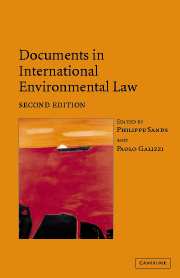Book contents
- Frontmatter
- Contents
- Preface
- PART I General instruments
- PART II Atmosphere
- PART III Oceans: global
- PART IIIB Oceans: regional
- PART IV Freshwater resources
- PART V Biodiversity
- PART VIA Hazardous substances and activities: nuclear
- PART VIB Hazardous substances and activities: pesticides
- PART VIC Hazardous substances and activities: waste
- PART VII Human rights and the environment
- PART VIII War and the environment
- PART IX Trade and the environment
- PART X Environmental impact assessment and access to information
- PART XI Liability for environmental damage and breaches of environmental obligations
- 42 International Convention on Civil Liability for Oil Pollution Damage, 27 November 1992
- 43 International Convention on the Establishment of an International Fund for Compensation for Oil Pollution Damage, 27 November 1992
- 44 Articles on the Responsibility of States for Internationally Wrongful Acts, adopted by the International Law Commission at its fifty-third session, 2001
- 45 Convention on Civil Liability for Damage Resulting from Activities Dangerous to the Environment, 21 June 1993
- 46 International Convention on Liability and Compensation for Damage in Connection with the Carriage of Hazardous and Noxious Substances by Sea, 3 May 1996
- PART XII The Antarctic
42 - International Convention on Civil Liability for Oil Pollution Damage, 27 November 1992
Published online by Cambridge University Press: 05 June 2012
- Frontmatter
- Contents
- Preface
- PART I General instruments
- PART II Atmosphere
- PART III Oceans: global
- PART IIIB Oceans: regional
- PART IV Freshwater resources
- PART V Biodiversity
- PART VIA Hazardous substances and activities: nuclear
- PART VIB Hazardous substances and activities: pesticides
- PART VIC Hazardous substances and activities: waste
- PART VII Human rights and the environment
- PART VIII War and the environment
- PART IX Trade and the environment
- PART X Environmental impact assessment and access to information
- PART XI Liability for environmental damage and breaches of environmental obligations
- 42 International Convention on Civil Liability for Oil Pollution Damage, 27 November 1992
- 43 International Convention on the Establishment of an International Fund for Compensation for Oil Pollution Damage, 27 November 1992
- 44 Articles on the Responsibility of States for Internationally Wrongful Acts, adopted by the International Law Commission at its fifty-third session, 2001
- 45 Convention on Civil Liability for Damage Resulting from Activities Dangerous to the Environment, 21 June 1993
- 46 International Convention on Liability and Compensation for Damage in Connection with the Carriage of Hazardous and Noxious Substances by Sea, 3 May 1996
- PART XII The Antarctic
Summary
Editorial note
The international regime on civil liability for oil pollution damage was originally found in the 1969 Convention on Civil Liability for Oil Pollution Damage. The 1969 Convention was the subject of three amending Protocols, most recently by the 1992 Liability Protocol. With the entry into force of the 1992 Protocol the 1969 Convention is known as the 1992 International Convention on Civil Liability for Oil Pollution Damage.
The Convention establishes the liability of the owner of a ship for pollution damage caused by oil escaping from the ship as a result of an incident on the territory of a party (including its territorial sea), and covers preventive measures to minimise such damage (Articles II and III(1)). ‘Pollution damage’ is defined as ‘loss or damage caused outside the ship by contamination resulting from the escape or discharge of oil from the ship, wherever such escape or dischargemay occur, provided that compensation for impairment of the environment other than loss of profit fromsuch impairment shall be limited to costs of reasonable measures of reinstatement actually undertaken or to be undertaken’ (Article I(6)(a)) and ‘the costs of preventative measures and further loss or damage caused by preventative measures’ (Article I(6)(b)).
The Convention establishes joint and several liability for damage which is not ‘reasonably separable’, and allows a limited number of exceptions, including war and hostilities, intentional acts, governmental negligence and contributory negligence, and it extinguishes all other claims for compensation (Articles III(2) and (3) and IV).
- Type
- Chapter
- Information
- Documents in International Environmental Law , pp. 1181 - 1197Publisher: Cambridge University PressPrint publication year: 2004



